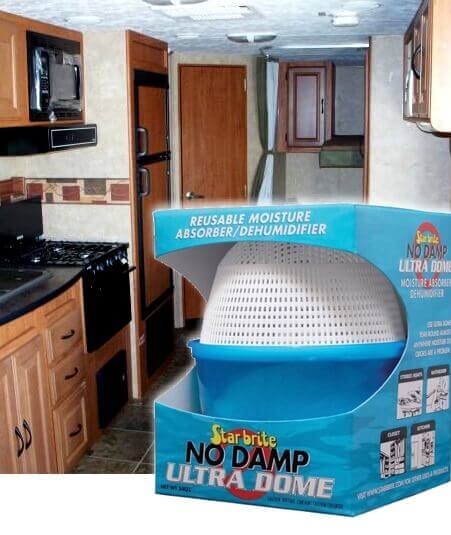 Last week, we discussed the benefits of using a dehumidifier during the winter, both for travel and storage purposes. This week we will look at the various types of available units in greater detail. This includes different sizes of both plug in and non-electric models, from manufacturers such as Eva-Dry, Starbrite, and Camco. While they all perform the basic function of preventing moisture build-up inside your RV, differences in operation and the intended purpose may sway your decision.
Depending on whether you are using a dehumidifier for RV travel or storage would be one of the main factors in choosing an electric or non-electric model. Electric models include the
EDV-1100 and EDV-2200 from Eva-Dry. The main difference between these two units is the relative size space they can accommodate. Both units have a water reservoir to collect moisture and run through the use of Peltier technology. Peltier technology indicates the type of cooling effect that is used to condense and collect the water in the air. Because they don't use compressors, so they can operate at a lower noise level. The EDV-1100 can work in spaces up to 1100 cubic feet with its 16 oz. reservoir, while the larger EDV-2200 can accommodate up to 2200 cubic feet with a 2 liter reservoir.
The Eva-Dry
EDV-500 is a bit of a hybrid model, as it does not need electricity while removing moisture, but it does need to be plugged in to 'renew' the silica gel crystals. Silica gel is a substance known for its moisture absorbing properties, and is used in a number of different ways. It has a compact design perfect for your camper or motorhome, and can last at least a month before renewing. This works well if you need a dehumidifier over an extended period. It is made for smaller areas than the other two Eva-Dry models, accommodating up to 500 cubic feet. This type is ideal for places such as closets and bathrooms. The blue crystals will draw in 8-10 oz over a period of time, turning pink when they need to be renewed. The renewal process can take at least 12 hours to complete, and needs to be done in a ventilated area, as once the unit is plugged in, it heats up and releases the stored moisture.
The common aspect of the completely non-electric models is that they are disposable or that the absorbing pellets need to be eventually replaced. They are the most ideal choice when using a dehumidifier for RV storage. Camco's
disposable dehumidifier uses calcium chloride to extract moisture from the air. Calcium chloride has prevalent moisture absorbing properties, so it would be best in areas with higher humidity. Dri-Z-Air has the advantage of full 360 degree coverage. The compact, and long, flat design is perfect for setting by windows to prevent condensation. Dri-Z-Air also uses calcium chloride, and will need to have its crystals replaced. Due to its compact size, the manufacturer recommends using three to cover a 25 foot motorhome. Starbrite units come in 3 versions, a 24 oz dome, a 36 or 12 oz bucket, or a disposable 14oz hanging pouch. They all work basically the same way, using pellets to draw in surrounding moisture and collecting it into liquid. The variety of sizes can cover several different size areas.
|